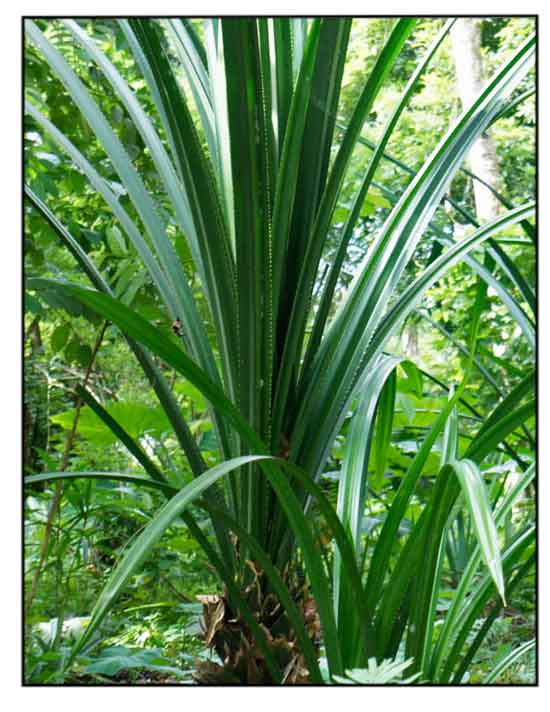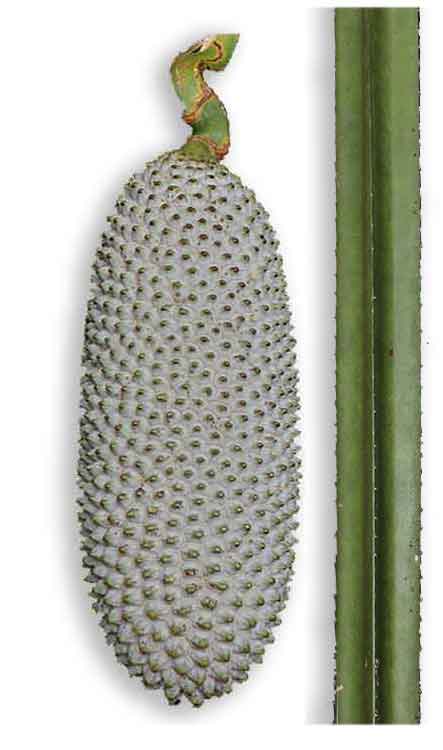 Gen info Gen info
- The genus Pandanus comprises approximately 700 species prevalent in tropical and sub-tropical regions.
-
Pandanus simplex was first described by the American botanist Elmer Drew Merrill in 1905. It is classified used the subgenus Kurzia, section Utilissima. (2)
Botany
• Karagumoy typically grows to 4 to 8 m (13 to 26 ft) tall. It has a round trunk around 12 to 15 cm (4.7 to 5.9 in) in diameter that is either unbranched or have a few branches. Prop roots emerge from the trunk near the base. Leaves are dark green elongated and very thick, around 3 to 6 m (9.8 to 19.7 ft) long and 6 to 10 cm (2.4 to 3.9 in) wide, with small sharp spines at the edges. Leaves are spirally-arranged leaves at the end of branches. The plant is dioecious with separate male and female plants. The fruits resemble jackfruit, an elongated capsule shape covered with small spines, typically 60 cm (24 in) or longer in length, and 20 cm (7.9 in) in width or wider.  (2)
Distribution
- Native to the Philippines.
 - Endemic. - Endemic.
- In forests at low to medium altitudes.
- Cultivated in farms, harvested every three months.
Constituents
- Study of MeOH extract afforded two γ-butyrolactones, algin (1) and pantolactone (2), a lignan, (+)-pinoresinol (3), and three sesquiterpenes, loliolide (4), (+)-dehydrovomifoliol (5), and vomifoliol (6). It is the first isolation of pantolactone (2), a degradation product of pantothenic acid in the liver, from a plant source. (3)
Properties
- Studies have suggested α-glucosidase, antidiabetic, anti-Alzheimer properties.
Parts used
Leaves.
Uses
Edibility
- Fruits and shoots are edible.
Folkloric
- No reported folkloric medicinal use.
Others
- Crafts: Leaves and fibers are widely utilized in the Philippines for weaving mats, baskets, hats. Also used for making ropes or thatching. (•) Pandanus simplex is the key figure of the "Pandan Festival" in Luisiana, Laguna, that showcases woven products and costumes. (5)
Studies
• Fungal Endophyte with α-Glucosidase Inhibitory Activity / Leaves: Study identified a fungal endophyte Annulohypoxylon stygium (Xylariales, Ascomycota) for the first time from the leaves of endemic tropical plant, Pandanus simplex. A crude extrac exhibited good inhibition of α-glucosidase enzyme with IC50 of 31.88 µg/mL. Results highlight the potential of A. stygium to produce metabolites that may be useful as antidiabetic drugs. (4)
• Potential Against Alzheimer's Disease: Study evaluated a total of 25 Philippine plant extracts for cytotoxicity using ATP cytotoxicity assay utilizing SH-SY5Y and HEK-293 cell lines. ELISA was used to to establish the down-regulation and aggregation of amyloid-beta in mutant cells against a positive control (phenol red) and negative control (untreated cells), in comparison with normal HEK-293 cells. Six plant extracts, including Pandanus simplex, prevented the oligomer aggregation of amyloid-beta in the mutant cells. The extracts were non-toxic to SH-SY5Y and HEK-293 cells. Results suggest potential as nutraceuticals to minimized the effects of AD. (6)
• Karagumoy Fiber-Reinforced Composite: Study evaluated the effects of enzyme treatment on the mechanical properties of natural fib er-reinforced composite using Pandanus simplex (karagumoy) fibers. Enzyme treatment improved the mechanical properties of karagumoy fibers with highest tensile strength value of 470,6590 MPa obtained at 4% xylanase concentration and one hour treatment. Enzyme treatment increased bonding between cellulose molecules and decreased affinity of karagumoy fibers to water, evidenced by low moisture uptake of enzyme-treated KFRCs. (7)
Availability
Wild-crafted.
Seeds in the cybermarket.
|

![]()



 Gen info
Gen info
